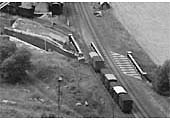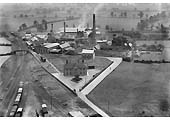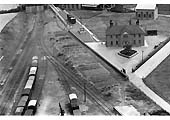 |
|
Stations, Junctions, etc
Engine Sheds
Other
|

|
Southam Cement Works (Long Itchington Works or Kaye's
Works)
Richard Greaves as born in 1801, a son of John Greaves, a
merchant of Stratford-on-Avon and a director of the horse-drawn tramway which
ran between Stratford on Avon and Moreton in Marsh He inherited part of his
fathers property and business empire, which included land at Wilmcote , Southam
and Stockton, which was suitable for quarrying blue lias limestone. Canals
formed an important adjunct to Greaves business and the canal which passed
through Wilmcote is said to have been diverted through that village to serve
his lime kilns. His lime was on the market in London in the 1830's and he
started to make artificial cement at his Stockton quarry. At Stockton, one of
the earliest lime works and later only a small cement works, was William
Griffin’s, but by World War I it had been quarried out and the land sold.
‘Charles Nelson & Co Ltd’ was also operating at Stockton by 1844,
first as lime burners, but from about 1860 was manufacturing cement, until near
bankruptcy in 1937 when ‘Rugby Portland Cement Co Ltd’ took a share
with a full takeover in 1945, after which it was completely closed down in
1949¹.
Sometimes called Long Itchington Works or Kaye's Works the
site was for a long time used for Blue Lias lime manufacture and had its own
dock on the Grand Union Canal for shipment as far as London. 'Cement' was
claimed as a product as early as 1854. However, as with nearby Rugby, it was
some time before a true Portland cement was produced, beginning around 1875.
Dry process bottle kilns were used. Of the six in use in 1875, probably three
were making cement, at 90 tons per week. Kilns were added piecemeal: by 1887
there were twelve kilns. Four more were added in 1892-4 and another four in
1902-4, giving in 1907 a capacity of 600 tons per week, although the kilns had
not all been used for Portland cement, capacity for that being only 240 tons
per week in 1901. The bottle kilns were decommissioned when the rotary kilns
were installed in 1908, except for a few kept for lime production.
The initial use of dry process seems not to have lasted
long, and kilns A1 and A2 were probably converted to wet process not long after
the installation of the wet process kiln A3. In any case, they were shut down
from 1915 to 1927 and were only used intermittently thereafter. The plant was
on its knees by the depression of 1932, with only one kiln operational and went
into receivership in 1934, at which point Rugby Cement bought it and commenced
a major re-build. Kilns A4 and A5 essentially re-sited the plant, and A3 was
used only intermittently from then on. The conversions of kilns A6 and A7 to
semi-wet process were 'energy reduction demonstration projects'. The use of a
Lepol grate on A6 provided a pilot for the much larger Rochester A6. The
two-stage pre-heater and crusher/drier on A7 was a development of the method
used on Pitstone A5, and prefigured subsequent semi-wet developments, including
that of Rugby A7. Both kilns were dogged by alkali build-up problems, and
neither gave particularly good energy performance. In the end, they were too
small to be viable. In addition to the canal, the plant also had a railway
connection through the L&NWR Weedon to Leamington branch from 1895. This
branch closed in 1963, but the plant still connected with Rugby through the
Rugby to Leamington branch until the latter closed in 1985. The plant was
demolished in 2011-2012. The quarry is still active, supplying Lias to Rugby
Cement's plant in Rugby.
Dylan Moore
¹ Southam Heritage
Aerial views of the Cement Works

Ref:
misc_scw163
English Heritage
First of three aerial views of Southam
Cement Works, Long Itchington, taken in 1932 |
 |

Ref:
misc_scw163a
English Heritage
Close up of the first of three aerial views
of Southam Cement Works, Long Itchington, taken in 1932 |
 |

Ref:
misc_scw163b
English Heritage
Another close up of the first of three
aerial views of Southam Cement Works, Long Itchington, taken in
1932 |
 |

Ref:
misc_scw164
English Heritage
Close up of the second of three aerial views
of Southam Cement Works, Long Itchington, taken in 1932 |
 |

Ref:
misc_scw164a
English Heritage
Second of three aerial views of Southam
Cement Works, Long Itchington, taken in 1932 |
Robert Ferris writes, 'the following table lists most of the
standard and narrow gauge locomotives purchased by Southam Cement works over
the years'.
Standard
Gauge
Locomotives |
| Locomotive |
Type |
Manufacturer |
Manufacturer's
Works No. |
Date Acquired |
Disposal |
| SOUTHAM |
0-4-0 Diesel |
Hudswell, Clarke & Co.
Ltd.
Railway Foundary, Leeds |
D604 |
1936 (New) |
|
| SOUTHAM No 2 |
0-4-0 Diesel |
Hudswell, Clarke & Co.
Ltd.
Railway Foundary, Leeds |
D625 |
1942 (New) |
|
| |
Narrow
Gauge
Locomotives (1 foot, 11½ inches) |
| Locomotive |
Type |
Manufacturer |
Manufacturer's
Works No. |
Date Acquired |
Disposal |
| JURASSIC |
0-6-0ST |
Peckett & Sons Ltd.
Atlas
Locomotive Works, Bristol |
1008 |
1903 |
|
| NEOZOIC |
0-6-0ST |
Peckett & Sons Ltd.
Atlas
Locomotive Works, Bristol |
1119 |
1906 |
Scrapped 1943 |
| LIASSIC |
0-6-0ST |
Peckett & Sons Ltd.
Atlas
Locomotive Works, Bristol |
1216 |
1909 |
Scrapped 1943 |
| TRIASSIC |
0-6-0ST |
Peckett & Sons Ltd.
Atlas
Locomotive Works, Bristol |
1270 |
1911 |
|
| MESOZOIC |
0-6-0ST |
Peckett & Sons Ltd.
Atlas
Locomotive Works, Bristol |
1327 |
1913 |
|
| |
0-6-0ST |
Peckett & Sons Ltd.
Atlas
Locomotive Works, Bristol |
1632 |
1923 |
|
| |
0-4-0ST |
W.G.Bagnall
Castle Engine Works,
Stafford |
2148 |
1924 |
Scrapped 1943 |
All the narrow gauge 0-6-0 Saddle Tank steam locomotives had
outside cylinders. There were also four narrow gauge 4 wheel petrol
locomotives, one of which was an ex-contractor locomotive obtained in 1936.

|
